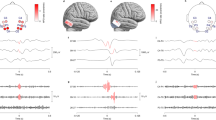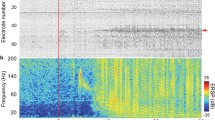Abstract
Introduction
Seizures are common in Intensive Care Unit (ICU) patients, and may increase neuronal injury.
Purpose
To explore the possible value of synchronization likelihood (SL) for the automatic detection of seizures in adult ICU patients.
Methods
We included EEGs from ICU patients with a variety of diagnoses. The gold standard for further analyses was the consensus judgment of three clinical neurophysiologists who classified 150 scalp EEG epochs as “definitely epileptiform,” “definitely nonepileptiform,” or “uncertain.” SL estimates the statistical interdependencies between two time series, such as two EEG channels. We computed the average synchronization by calculating the SL between one channel and every other channel, and taking the mean of these values.
Results
The mean SL in the 38 “definitely epileptiform” epochs ranged from 0.095 to 0.386 (mean 0.189; SD 0.066). In the 34 “definitely nonepileptiform” epochs the mean SL ranged from 0.087 to 0.158 (mean 0.115; SD 0.016; p<0.0005). The area under the ROC curve was 0.812 (95% Confidence Interval 0.725 to 0.898).
Conclusion
The mean SL may distinguish between seizure and nonseizure epochs, and may prove helpful to monitor epileptic activity in ICU patients.
Similar content being viewed by others
References
Towne AR, Waterhouse EJ, Boggs JG, et al. Prevalence of nonconvulsive status epilepticus in comatose patients. Neurology 2000;54:340–345.
Jordan KG. Neurophysiologic monitoring in the neuroscience intensive care unit. Neurol Clin 1995;13:579–626.
Claassen J, Mayer SA, Kowalski RG, Emerson RG, Hirsch LJ. Detection of electrographic seizures with continuous EEG monitoring in critically ill patients. Neurology 2004;62: 1743–1748.
Young GB, Jordan KG. Do nonconvulsive seizures damage the brain?—Yes. Arch Neurol 1998;55:117–119.
Scheuer ML, Wilson SB. Data analysis for continuous EEG monitoring in the ICU: seeing the forest and the trees. J Clin Neurophysiol 2004;21:353–378.
Gabor AJ. Seizure detection using a self-organizing neural network: validation and comparison with other detection strategies. Electroencephalogr Clin Neurophysiol 1998;107:27–32.
Saab ME, Gotman J. A system to detect the onset of epileptic seizures in scalp EEG. Clin Neurophysiol 2005;116: 427–442.
Pauri F, Pierelli F, Chatrian GE, Erdly WW. Long-term EEG-video-audio monitoring: computer detection of focal EEG seizure patterns. Electroencephalogr Clin Neurophysiol 1992;82: 1–9.
Salinsky MC. A practical analysis of computer based seizure detection during continuous video-EEG monitoring. Electroencephalogr Clin Neurophysiol 1997;103:445–449.
Van Putten MJ van, King T, Visser F, Lagerburg V. Detecting temporal lobe seizures from scalp recordings: a comparison of various features. Clin Neurophysiol 2005;116:2480–2489.
Faul S, Boylan G, Connolly S, Marnane L, Lightbody G. An evaluation of automated neonatal seizure detection methods. Clin Neurophysiol 2005;116:1533–1541.
Altenburg J, Vermeulen RJ, Strijers RL, Fetter WP, Stam CJ. Seizure detection in the neonatal EEG with synchronization likelihood. Clin Neurophysiol 2003;114:50–55.
Smit LS, Vermeulen RJ, Fetter WPF, Stijers RLM, Stam CJ. Neonatal seizure monitoring using non-linear EEG analysis. Neuropediatrics 2004;35:329–335.
Stam CJ. Nonlinear dynamical analysis of EEG and MEG: review of an emerging field. Clin Neurophysiol 2005;116:2266–2301.
Pijn JP, Velis DN, van der Heyden MJ, DeGoede J, van Veelen CW, Lopes da Silva FH. Nonlinear dynamics of epileptic seizures on basis of intracranial EEG recordings. Brain Topogr 1997;9: 249–270.
Stam CJ, van Dijk BW. Synchronization likelihood; an unbiased measure of generalized synchronization in multivariate data sets. Physica D 2002;163:236–251.
Lehnertz K, Elger CE. Can epileptic seizures be predicted? Evidence from nonlinear time series analysis of brain electrical activity. Phys Rev Lett 1998;80:5019–5022.
Martinerie J, Adam C, Le Van Quyen M, et al. Eplleptic seizures can be anticipated by non-linear analysis. Nat Med 1998; 4:1173–1176.
Le Van Quyen M, Martinerie J, Navarro V, et al. Anticipation of epileptic seizures from standard EEG recordings. Lancet 2001;357: 183–188.
De Clercq W, Lemmerling P, Van Huffel S, Van Paesschen W. Anticipation of epileptic seizures from standard EEG recordings. Lancet 2003;361:970.
Aschenbrenner-Scheibe R, Maiwald T, Winterhalder M, Voss HU, Timmer J, Schulze-Bonhage A. How well can epileptic seizures be predicted? An evaluation of a nonlinear method. Brain 2003;126:2616–2626.
Lehnertz K, Litt B. The first collaborative workshop on seizure prediction: summary and data description. Clin Neurophysiol 2005;116:493–505.
Van Putten MJ. Nearest neighbor phase synchronization as a measure to detect seizure activity from scalp EEG recordings. J Clin Neurophysiol 2003;20:320–325.
Rulkov NF, Sushchik MM, Ysimring LS, Abarbanel HDI. Generalized synchronization of chaos in directionally coupled chaotic systems. Phys Rev E Stat Nonlin Soft Matter Phys 1995;51: 980–994.
Takens F. Detecting strange attractors in turbulence. Lecture notes in mathematics 1981, 898:366–381.
Theiler J. Spurious dimension from correlation algorithms applied to limited time-series data. Phys Rev A 1986;34:2427–2432.
Author information
Authors and Affiliations
Corresponding author
Rights and permissions
About this article
Cite this article
Slooter, A.J.C., Vriens, E.M., Leijten, F.S.S. et al. Seizure detection in adult ICU patients based on changes in EEG synchronization likelihood. Neurocrit Care 5, 186–192 (2006). https://doi.org/10.1385/NCC:5:3:186
Issue Date:
DOI: https://doi.org/10.1385/NCC:5:3:186




